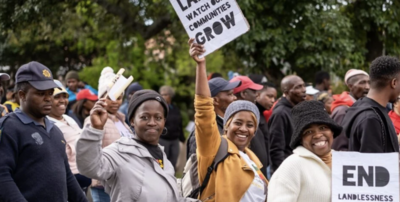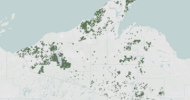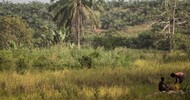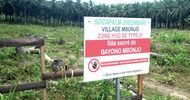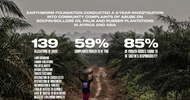Rights and Resources Initiative | January 2010
Fodder for war: Getting to the crux of the natural resources crisis
Liz Alden Wily
As the world's governments and international enterprise become increasingly interested in land acquisition for food production, the importance of legal customary tenure recognition becomes more apparent. This presentation was given to a Public Meeting at the Overseas Development Institute, London, 26 November 2009, to launch Uncharted Territory: Land, Conflict and Humanitarian Action, ed. Sara Pantuliano, Practical Action Publishing, 2009.
Natural Resources Crisis*
JANUARY | 2010 Liz Alden Wilyland to loggers, miners, rubber or other plantation
INTRODUCTIONcompanies, and especially now, commercial food
Let me begin with a polemic to get my main pointand bio-fuel producers. Best if you can back this up
across as to the connection between inequitablewith a contract which will hold under international
land rights and conflict.law, and even better to back in up with a State to
Let me put it this way: what is the best way to State agreement.start a civil conflict today?
But don’t forget to pay the customary land ownersWell, one way is territorial invasion and respondent a little something for the crops or buildings they
resistance. This has a pretty solid history – and is lose; this will help keep resentment down.still seen in some of the older conflicts grinding on Obviously you don’t have to do this for the forests,
today (the Basque and Kurdish conflicts, Israel/ pastures or other lands which are not farmed. ForPalestine) but we are seeing this less and less - with there really is no visible evidence that these lands
one or two painful recent exceptions (Chechnya, are ‘theirs’. Look, the trees are still standing. [If youOssetia, Iraq). need more excuses to concur with the likely
PARTNERS national law of that country, then you have it inThere is a simpler way, and one which can produce two facts: they hold the unfarmed communally, not
much more chronic conflict: first, operate in an as single owners. In addition, it seems that when itagrarian state. This is a country where most of the comes to unfarmed land, the community by
population depends upon land, not jobs, for custom does allow this to be sold. And we all knowsurvival. Then curtail their rights to those that ‘property’ is only ‘property’ when it is fungible,
resources; land, forests, pastures, rangelands and able to sold. Well, that’s what western law sayswetlands. The easiest way to do this is actually to anyway, and it is always right].
do nothing, just sustain often old colonial policieswhich deny that these rights exist; that is to say, Now offer a few jobs in your new enterprise. Or
that these rural communities are in law no more better still, like the Chinese in Cameroon today,than permissive occupants and users of national or hand out a few ‘bodo bodo’ bicycles with large
State land. back seats and front baskets so they can leave thearea altogether and start taxi services in town. And
Then, add to this the ‘needs’ of the State and its then ignore the matter and let it fester...associated elites with their deep pockets. Lease this Does this sound unlikely? Well, no. Over the last
half century nearly one hundred of the world’scountries, many of them bitterly poor, have tended
* This presentation was given to a Public Meeting at the Overseasto this position. In so doing they deny that
Development Institute, London, 26 November 2009, to launch Unchartedlongstanding rural populations own the land they
Territory: Land, Conflict and Humanitarian Action, ed. Sara Pantuliano,Practical Action Publishing, 2009.
and their forefathers have lived on for centuries. InJANUARY | 2010
Meanwhile many other poor economies which hadtheir well-crafted laws, they gently take away these
limited feudal inequities to repair, simply persistedproperties, the very assets they need to clamber
in the convenient notion that such lands don’tout of poverty.
belong to people but to government, in the interestof public purpose. It is around these precious
In one way or another we are seeing the results onresources that most contestation now begins to
every agrarian continent, whether it is the peri-show itself. Whose land is it? is the cry beginning to
urban villages of China, the forest dwellingbe heard from state to state.
populations of the Congo Basin, the customarylandholding majority in most African states, the
My concern is that our new century may be rivenindigenous and introduced slave populations of
with as much civil conflict as the last andLatin America, or simply the long forbearing
inequitable land relations may be as big a factor asland-poor of South Asia, who still till the land for
in the past.generation after generation for unreformed feudal
landlords, most of whom are businessmen andLooking back in terms of property relations, the
bureaucrats and don’t even live on the farm20th century ended with significant progress in
(Pakistan, India, Nepal, Bangladesh).more equitable distribution of farmlands around
much of the agrarian world.The point I am trying to make is straightforward:
that equitable land relations matter and thatLooking forward, we can expect significant
sustained abuse takes its toll.progress in the redistribution of property power
between people and the State by the end of theWe don’t have to look far for the evidence. The 20th
century. However, like the last, without clear andcentury was one of state to state war. But it also
pre-emptive will to reform, this may not occurwas a century of rebellion, revolution, and civil war,
without rebellion, conflict, and even civil war.and radical transformation of political systems, at
least partly brought about by resistance toThis is why working to tackle the inequitable
persisting feudal land norms. More than 50property relations that underwrite so much of
different countries were forced to reform the waymodern, struggling agrarian society is the urgent
they treat rural land ownership. In practice, wellproject of the ‘now’.
under half made significant progress and challengeto feudal land relations remains on the agenda
In the process, we must hope to see two importanttoday.
structural changes in the agrarian world. Firstly, adegree of reconstruction of the agrarian State itself
And even were reforms were undertaken, manyas it revitalises its role as serving, not taking from
administrations, took the opportunity to captureits citizenry. Secondly, we need to see new meaning
naturally collective assets in particular – theof ‘development’; development as meaning
forests, woodlands, wetlands, and pastures of ruralprogressive agrarian enterprise which is founded
communities. Through this the State, if not theupon the landholding rights of the rural poor, not
feudals, remained into the 21st century thebuilt upon its dispossession. In this way we can
majority landlords, while the natural andhope to see the indigenous peoples of Peru for
customary owners remained dispossessed.example, or the ordinary rural communities of the
3DRC, become rightful shareholders in social change, how much more natural forest estate is being
not its casualties. acknowledged as community property.MAIN POINTS 2 However progress is too dangerously slow
- probably too slow to yet prevent risingLet me summarise ten main background points.
numbers of civil conflicts – and the costs are1 Progress is being made in connecting mounting.
inequitable land relations and conflicts.In Afghanistan for example, failure since the Bonn
Land and property issues are now better Agreement to swiftly resolve bitter inter-tribalplaced on the agenda than they were even five conflict as to pasture access that stems from
years past. Humanitarian and reconstruction disputed State ownership, is opening a new front inagents in conflict states are taking a deeper look at the ongoing war against insurgents. Taliban have
the issues and moving beyond a narrow focus upon begun to actively support and arm fellow Pashtunrestitution of property wrongfully taken during the tribesmen in this land conflict. This now raises the
war. The knee-jerk reaction of donors to solve land prospect of reactive threat of Iranian support forproblems with house and farm registration, is often the non-Pashtun Shia tribes. Meanwhile, the land
being rethought. conflict can be seen to be handing the Taliban witha new and powerful social agenda. A taste of this
In the land tenure reform sector as a whole, and was seen in Pakistan in early 2009 as Talibanwithin and outside conflicted states, great progress grasped the utility of engaging landless tillers in
has been made since 1995 in revisiting the position their war against entrenched feudal notables.of most agrarian populations as tenants of State.
In Sudan a more typical source of future conflictIn Latin America this has focused on indigenous unfolds. A main cause in the long North-South civil
peoples, with a rising number of land grants. In war from 1984 was State leasing of some millions ofAfrica this more widely embraces entire rural hectares of customary rangelands and woodlands
populations through changing the legal status of to entrepreneurs, including foreigners, on the basisunregistered and customary ownership in national that these belonged to Government, not local
laws. In Asia and Central Asia both in different ways communities. Despite pledging to reassess thecautiously and much more slowly begin to apply. status of customary property interests in the Peace
We see this is the quietly increasing grip of Agreement of January 2005, President Omar alcustomary tenure in Indonesian law, in the way in Bashir has re-launched mass leasing of lands. An
which Nepal, Afghanistan and Liberia ponder the estimated five million ha are already in the handsusefulness of retaining all pasture and forest of State or state-supported enterprise of Egypt, Abu
resources as state property. Dhabi, Bahrain, Jordan, Kuwait, Saudi Arabia, UAEand South Korea – for rice, maize, dairy, livestock
As a whole, the balance of State-people landholding production. All this is to feed their own food-shortis shifting (for the issue at this point is first and populations. Needless to say, militias are allegedly
foremost an issue of their property relationship, reforming in many of the affected areas.rather than among social classes). Observant
3 The key source of the problem is commonforest-related agencies, for example, begin to note
across agrarian states. It is that most ruralJANUARY | 2010
intentions, but in the growing angry response bypopulations in agrarian economies are still
the rural poor [see Robin Palmer’s excellentlittle better than squatters on their own land,
collation of clippings and papers].in the eyes of their country laws.
Not surprisingly, this makes their collective
5 Mining, logging, ranching, farming, and otherproperties most vulnerable; the areas which they
commercial enterprise are hardly illegitimate.sensibly retain as community owned rather than
individual or family land: forests and rangelands,Poor countries and ordinary farmers need
often full of minerals and water.investment and technical expertise. This is not
disputed. What must be disputed is the strategy:This is not a small problem. It affects over one
the failure to root these developments on abillion of the world’s rural poor in Asia, Central Asia,
platform of local tenure recognition. To do soLatin America, and Africa.
would structure enterprise with, rather than4 Nor is it coincidental that these are the areas against, rural populations. It is this failure which
– and especially in Africa – where most civil has the most potential to generate new conflict inwars and lesser conflicts are rife. these countries.
In January 2008 when I was preparing the chapter in Consider the facts: who, for example, are theUncharted Territory: Land, Conflict and traditional and continuing customary owners of
Humanitarian Action, I identified 70 significant the ten million ha of valuable rural real estatecurrent conflicts in 43 states, the most recent of which the Government of the Democratic Republic
which was in Kenya where post-election violence of Congo is reported to have offered to a Southsegued quickly into inter-tribal battles over African Farmers Union for development? Who is the
ancestral lands. Only 15 of the 70 conflicts were not natural owner of the 10,000 ha which the Cameroonin agrarian economies and nearly half (48%) were in Government has leased to China for rice production
Africa. On further examination, there is a close and where, perhaps to the surprise of the Chinesecorrelation of conflict with (i) the proportion of company, they have begun to find is not vacant,
land area under state rather than citizen unoccupied or unowned land after all?ownership; (ii) the existence in rural areas of
6 Conflict in and around this grievance canmajority unrecognised customary ownership; (iii)
increase – and the signs are it will increase.levels of rural poverty and institutional weakness
– and increasingly, (iv) a correlation withThe current ‘global land grab’ is merely grist to the
proclaimed land availability for inter-statemill. Popular response to the plan to lease 1.3
supported biofuel and especially food farmingmillion ha of customary property in Madagascar to
leases.the Daewoo Corporation saw the fall of the
government in March 2009. Tanzanians haveOf course this is not entirely new, as it follows on
queried the lease of their common properties tofrom some decades of equally dispossessory
Chinese and other investors and new developmentsleasing of forest estate and pasturelands for
have been paused.logging and mining enterprise. A quick run through
the press over the last couple of years in Africamakes salutary reading, not just in respect of the
5seeking food security but to make money out of
Yet it would be wrong to say that just solutions willfood insecurity, rising food shortages and prices,
be easily reached. Rumour has it that the responsethat is, from both the harvests and the land itself.
of the Tanzanian Government for example, hasThey seek land in mainly Africa because it is cheap
been to consider amending recently reformed landto lease, bountiful and host Governments seem
law which recognised community ownership of notonly too eager to rent out ‘their’ lands. So far this
just farms and houses, but communal properties ofhas been through less-than-transparent
each community to rid itself of this now apparentagreements and within which local benefit is vague
obstruction. In Ethiopia, the position of ultimateat best.
State ownership over all land has allegedlyhardened to facilitate the many new foreign
GRAIN, among others (e.g. the UN Specialbusiness land occupations.
Rapporteur on the Right to Food), also throws cold7 There are elements in the process which are water on the time-old response of the industrial-
provocative to not just human rights but backed international community (notably FAO andcommon sense. The World Bank, Japan and the G-8) to this
threatening conflict of interest. The responseThe leasing of land by foreign governments and comes in the form of establishing a ‘win-win’ code
their agencies to feed their own populations most of conduct for foreign land and food securityafflicts Africa. This is a continent where few investments. The international press has broadly
countries produce enough to feed themselves and welcomed this. A sigh of relief around internationalwhere a third of the population is hungry. Among agencies and companies can be heard. The
the 40 million ha known to have been leased since argument is ‘agricultural investment is needed andlate 2007 or under negotiation, half is in Africa. This this will be good for African economies, so let’s
is in countries where poor rural majorities live and make it work’. GRAIN raises the point that even thedepend upon not just farming but forest/woodland food security is unsound, that the answer lies not
and rangeland use: Ethiopia, DRC, CAR, Sudan, in the north taking and farming the lands of theCameroon, Kenya, Angola, Madagascar, south, but building upon existing family farm and
Mozambique, Zambia, and Malawi. local market development in poor agrarian states.The real question, GRAIN says, is not ‘How do we
Local livelihood is almost always organized on a make these investments work? But ‘What farmingcommunity or village basis, each community having and food systems will feed people without making
both its family farming areas and shared non- them sick, keep farmers on the farm instead of thefarmed resources. These are the target for city slums, and allow communities to prosper and
investors, and easily accessible because host thrive?’governments either claim these lands are unowned,
or hold them in trust for local communities, a trust To this might be added the now-doubted returns ofwhich it has proven all too easy to abuse. large-scale estate farming in labour-rich economies
over the last sixty or so years. So too must a futureGRAIN reports that more foreign state or agency be challenged on moral and common sense
land for food applications and offers are in the grounds where African nations become thepipeline. It remarks the trend of private investors farmyard of the industrialised world and the
getting in on the act: hedge funds, private equity Middle East, not quite the client future whichgroups, and investment banks. This sector is not Africans envisioned for themselves.
JANUARY | 2010humanitarian community, long used to focusing
upon the plight of refugees and displaced persons,But history endlessly repeats itself and
a new version of displacement will present itself,justifications can always be found. As recently as
involving growing numbers of farmers displacedthe 1970s large scale investor-based farming
from their own lands by the hand of their owndispossessing customary owners caused war in
unthinking governments.Sudan as much as the hacienda culture of Latin
America generated revolution after revolution last9 Of course there is remedy - and a relatively
century. In the 1880s Europeans claimed that theirsimple one at that – in principle.
carve-up of Africa was for the good of nativepopulations, for they would ‘gain Christianity and
This rests in long-overdue acknowledgement ofcivilisation’. Today, those who make the deals will
customary land rights as equivalent to privatecertainly be able to fill their pockets. For rural
property rights in this modern day and age and tocommunities themselves? Well, they will gain some
be upheld in national constitutions and land lawsjobs (although the Chinese for one will bring their
as such. This is whether or not these lands areown labour) and some foodstuffs produced will
customarily owned by individuals/families orreach the local host market. But the costs will be
communities; whether or not the land is farm,enormous, and not just the loss of use of their
forest or pasture; and whether or not local customtraditional lands. Affected rural communities will
allows the latter classes to be sold outright or not.lose their possession of this latent capital.
8 Moreover, the prospect of ever regaining As legally recognised land owners, communities,secure tenure will be diminished. not the state, would then become the rightful and
logical lessor to non-local enterprise, should theyThe fragile process of securing tenure which is so wish. This can and should happen by the
quietly advancing in these affected continents will assisting and vigilant hand of the State itself,slow down or even be abandoned, as Governments government agencies fulfilling their rightful duty
make their choice in favour of global agriculture in to assist their citizens –not themselves - to developthe interests of proclaimed greater economic good, their assets.
and most likely, through retaining and deepeningmalformed norms and arrangements. Of course this is less easy in practice. It requires
modern Governments to surrender their landlordGlobal agriculture will take off and affected roles over the most sought after resources in the
communities will find a curious shift in their world. Already even those who have madeproperty relations: where before they were in the significant progress in securing customary land
eyes of the law tenants of State, now they will be rights (e.g. Tanzania, Uganda, Mozambique inmore accurately tenants of corporate international Africa) are found to be in danger of falling at the
enterprise. first attractive challenge to citizen land rights.Everywhere, a clearer and tighter set of country
And not all can or will remain on these lands as legal norms need promotion and support. Thisemployment, such as it is, contracts with the means rooting customary land rights in such a
‘economic necessity of efficiency’. For the manner that it is these owners, not governments orother agents, who become the direct shareholding
partners in the commercial development of their RESOURCESlands. This has to directly include not just their
houses and farms, but the target of most land Refer to Pantuliano, S. (ed). 2009. Land, Conflict andgrabbing past and present whether it has been Humanitarian Action. Practical Action
local or international - the yet uncultivated Publishing, UK.rangelands, woodlands and forests which belong And:
today and customarily to these rural communities. Agencies. 2009. South Koreans acquire hugefarmland in Tanzania. Daily Nation, Kenya,
To achieve such changes requires a mindset September 25, 2009.change, and in a time when vested interest, Alden Wily, L. 2008. Whose Land is It? Commons and
corruption, and greed militate against change, and Conflict States Why the Ownership of thewhere the meaning of ‘good government’ has lost Commons Matters in Making and Keeping
its way. This suggests a needed reconstruction of Peace. Rights and Resources Initiative,the State. Perhaps as of old, this may take civil Washington.
-----. Forthcoming. Africa’s big question. Can theunrest if not war to be forced upon benighted
continent find solutions to its colonial landagrarian populations. Whichever way we look at it,
ownership legacy? In Special Newsletter,the sorry truth is that conflict over natural
Tropical Forest Update, ITTO.resources and how they are and should be owned,
-----. Forthcoming. Resolving Tenure Conflicts tois probably on the agenda. And sadly, the continent
Limit War. A Case from Afghanistan inwhich can least afford it, Africa, is the most
Strengthening Post-Conflict Peacebuildingvulnerable.
through Natural Resource Management, Vol. 410 Finally, why should the humanitarian (ed. H. Young), Environmental Law Institute and
community be concerned over these issues? UNEP.Cotula, L., S. Vermeulen, R. Leonard, and J. Keeley.
The answer to this is simple. It is they, not those 2009. Land grab or development opportunity?who make the policies and deals, who have to clean Agricultural Investment and international land
up in civil conflicts, find the shelter and food for the deals in Africa. FAO, IIED and IFAD.displaced and dispossessed. Whether it is Fuys, A., E. Mwangi and S. Dohrn, 2008. Securing
burdensome or not, humanitarian actors need to Common Property Regimes in a Globalizingbecome informed and participate in every possible World.Synthesis of 41 Case Studies on Common
way to prevent, not just treat, the emerging land Property Rgimes from Asia, Africa, Europe andwar. Latin America. CAPRI & International Land
Coalition, Rome.GRAIN. 2008. Seized! The 2008 land grab for food and
financial security, Briefing and Annex. GRAIN,Rome.
-----. 2009. Stop the global land grab! GRAINstatement at the joint GRAIN-La Via Campesina
media briefing.Laishley, R. 2009. Foreign acquisitions: some
opportunities, but many see threats. UnitedNations Africa Renewal, 11 November 2009, New Taylor, M. and T. Bending, 2009. Increasing commercial
York. pressure on land: Building a coordinated response.Mande, M. 2009. Public fury halts biofuel onslaught International Land Coalition, Rome.
on farmers. The East African, October 5-11 2009. The Economist. 2009. Outsourcing’s third wave. BuyingPalmer, R. 2009a Select Bibliography of Reports on farmland abroad. May 23rd-29th 2009, London.
Biofuels, Land Rights in Africa & Global Land UN-HABITAT, 2009. Quick Guide to Post-Conflict Land Issues:Grabbing, Mokoro Ltd, Oxford. Discussion Draft June 2009.
-----. 2009b. Select Bibliography of Press Cuttings on Vallely, P. 2009. Wish You Weren’t Here: The DevastatingBiofuels, Land Rights in Africa & Global Land Effects of the New Colonialist. The Independent, August
Grabbing, Mokoro Ltd, Oxford. 10, 2009.Perlez, J. and P. S. Shah, 2009a. Taliban Exploit Class Von Braun, J. and R. Meinzen-Dick, 2009. ‘Land Grabbing’ by
Rifts in Pakistan. The New York Times, April 17 Foreign Investors in Developing Countries: Risks and2009. Opportunities. IFPRI Policy Brief 13 - April 2009. IFPRI.
-----. 2009b. With Stubborn Unrest in Swat, Wheeler, S. 2009. South Sudan looking into US land deal.Landowners Remain in Exile. The New York Reuters, January 27 2009.
Times, July 28, 2009. Wikipedia. Past and Current Wars.Rice, A. 2009. Is There Such a Thing as Agro- Von Braun, J. and R. Meinzen-Dick, 2009. ‘Land Grabbing’ by
Imperialism? The New York Times, November 22, Foreign Investors in Developing Countries: Risks and2009. Opportunities. IFPRI Policy Brief 13 - April 2009. IFPRI.
Rights and Resources, 2008. Seeing People Through Wheeler, S. 2009. South Sudan looking into US land deal.the Trees Scaling Up Efforts to Advance Rights Reuters, January 27 2009.
and Address Poverty, Conflict and Climate Wikipedia. Past and Current Wars.Change. Washington.
RSBP, 2009. New Scramble for Africa hits Kenyanwildlife oasis. Press Release, 24 June 2009.
Sunderlin, W., J. Hatcher and M. Liddle, 2008. From ABOUT THE AUTHORExclusion to Ownership? Challenges and Liz Alden Wily is an international land tenure specialist and a
Opportunities in Advancing Forest Tenure Rights and Resources Initiative Fellow.Reform. Rights and Resources Initiative,
Washington.Wily, Liz Alden. (Contributing Author). Fodder for War: Getting to the Crux of the National Resources Crisis.
Washington: Rights and Resources Initiative, 2010.The Rights and Resources Initiative is a global coalition to advance forest tenure, policy, and market
reforms. RRI is composed of international, regional, and community organizations engaged in conservation,research, and development. For more information, visit www.rightsandresources.org.
This publication was made possible with the support of the Ford Foundation, Ministry for Foreign Affairs ofFinland, Norwegian Agency for Development Cooperation, Swedish International Development Cooperation
Agency, Swiss Agency for Development and Cooperation, and UK Department for InternationalDevelopment. The views presented here are those of the authors and are not necessarily shared by the
agencies that have generously supported this work, nor all the Partners of the coalition.

